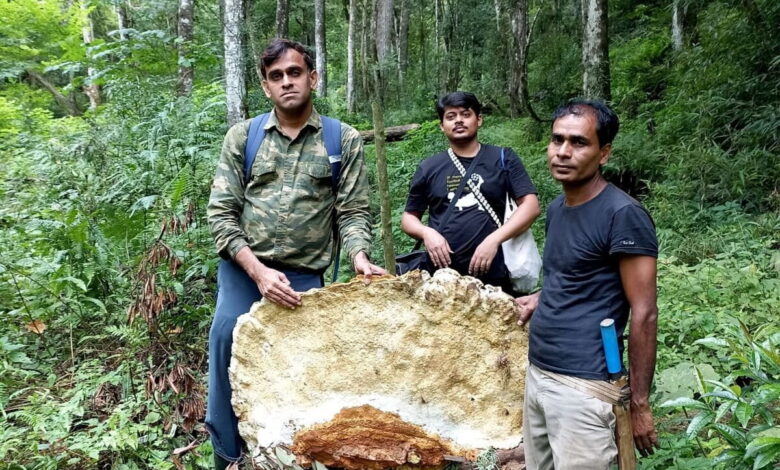New fungi species in Arunachal that’s larger than life
Bridgeoporus kanadii was discovered in Arunachal Pradesh by Botanical Survey of India researchers.

They do strange things to time, because it is not easy to say where a fungus ends or begins, when it is born or when it dies,” wrote Robert Macfarlane in Underland. The rule-defying, yet understated kingdom of fungi has captivated scientists and writers globally in various landscapes, yielding impressive learnings.
For example, the mutualistic relationship between fungi and plants is one that has been cultivated over millions of years. Fungi extract carbon stored in trees, and in return provide rich nutrients like nitrogen to the trees. Fungal networks in the soil act like a reliable public transport system for messages between trees. A dying tree may direct its remaining nutrients to others through fungi. A pest-ridden tree may send warnings to trees in the vicinity to shield themselves.
While our understanding of fungal diversity in India remains under-studied, a recent discovery brings them to the spotlight as a ‘colossal’ new species has been described in Arunachal Pradesh.
A fungus with a taste for timber
Bridgeoporus was a previously monotypic genus, with only one species – Bridgeoporus nobilissimus – belonging to the genus for decades until B. sinensis was collected in China.
“Taxonomy is an ever-evolving field, with scientists reclassifying species over time at their discretion. B. sinensis was eventually moved to another genus, Oxyporus. This made our finding in Arunachal the second species known in the genus – Bridgeoporus kanadii,” said Arvind Parihar, lead author of the study and a researcher with Botanical Survey of India (BSI) who has been focusing on macro fungi for more than 15 years. The other authors of the study are also with BSI.
Parihar and his colleagues stumbled upon no less than 40 of the thick, leathery fruiting bodies of the new species growing on old growth Abies or fir trees in forests in West Kameng district. The team had been conducting a survey of wild, edible mushrooms across the state at the time.
What makes the genus stand out is its sheer size – the smallest was nine centimetres in radius, and the largest grew wider than three metres. “It is so large that I could sit on it, and it remained firmly attached to the tree,” said Parihar. Moreover, the fungus was largely seen on dead fir trees – those that were alive and sported the fungus ultimately died.
Local community members were aware of the presence of B. kanadii, but did not extract it as the fungi is inedible and not economically valued.
“We brought the specimen back to our office in Itanagar, where we sundried and preserved it. We conducted a standard macro-morphological study, recording its colour, size, shape, thickness, length and width, among other parameters,” said Parihar. A micro-morphological study was also carried out by the team, and DNA sequencing conducted on Geneious Pro v. 5.1, an integrated bioinformatics software.
The DNA sequences of other Bridgeoporus species from GenBank were compared to the newly sequenced data of B. kanadii to check dissimilarity in phylogeny and morphology and thus confirm a separate species. The specimen collected by Parihar is now exhibited at Central National Herbarium in Howrah, West Bengal.
Housekeepers of the forest need the limelight
The pursuit of understanding our fungal diversity comes with its challenges, from a lack of funding to several roadblocks during fieldwork. Fungi emerge during the monsoon, when heavy rains render deep forest areas inaccessible.
Once samples are collected, researchers must overcome a different set of challenges. “We need to spend hours looking into the microscope to study them. At least 50-60 characteristics must be recorded on the day of collection before we dry and store samples in airtight bags,” Parihar said.
There is much to admire about fungi, despite the less-than-deserved attention they get from the scientific community. “The lens with which we look at fungi is far too limited. Most people only ask: is it poisonous or edible? But all fungi silently work to maintain our ecosystems. Without fungi, forests will be full of debris, logs and leaf litter left undecomposed,” said Parihar.
Bridgeoporus species are vital in the housekeeping of forests, by decomposing forest litter, particularly dead wood. “Wood rotting fungi are an important group of fungi which play an indispensable role in the intricate tapestry of carbon and nutrient cycling, because of their unique capacity to degrade cellulose and lignin,” stated the study. The decomposition of forest litter is directly tied to nutrient recycling, health of the soil microbiome and the growth of new plants. In essence, the fungi contribute towards forest health and regeneration.
(The article was first published in Mongabay)





